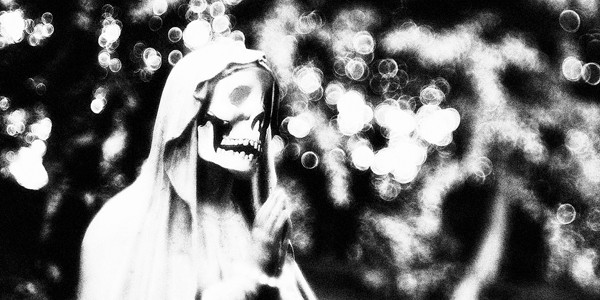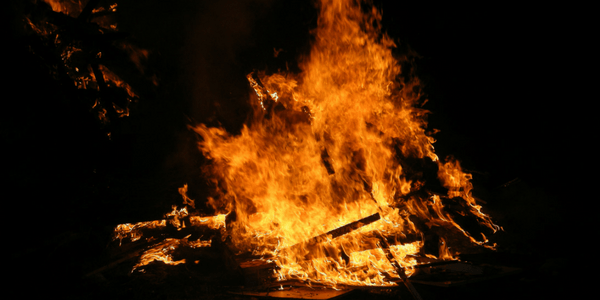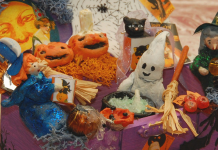
There’s no denying that for many Pagans, witches, and occultists, Samhain is a favourite sabbat, one those eight holidays that make up the Wheel of the Year.
Perhaps it is because Samhain marks the beginning of the festive period right through to the New Year, something to look forward to as the darkness and cold of winter begin to creep in and take hold.
Origins
The name Samhain, like many of the sabbats, takes its name from the Celts, and is associated with the Irish. It’s always important to remember that when talking about the Celtic peoples, and indeed so many others, that it is a broad term encompassing many different regions and tribes and groups of people. As such, there are no definitive or set rules regarding what the ancient Celts did during Samhain, only that it was a time of slaughter and of feasting. The weakest animals, the ones who would not survive the winter would be sacrificed and eaten, giving the people enough meat to last the harsher months as well as saving on feed for the herd.
It’s also important to remember that the four seasons we are familiar with today are also something of a modern invention, so the Celts would have only known summer and winter.
Samhain was a time of endings and beginnings. The end of the summer months and the beginning of the winter months as such it was seen as something of a magical time.
It’s easy to imagine that in this liminal time, and with the approach of winter and visible signs of death all around, that the Celts believed the boundary between the worlds of the living and the dead would be thinnest at this time, and that the dead would return like the cold winds of winter.
Related: Hallowe’en: From community celebration to sabbath of evil, by Donyae Coles
Related: Samhain, reviewed by Syndee Barwick
Related: Deepen your connection to the land throughout the Wheel of the Year, by Emma Kathryn
A modern celebration
Today, witches and Pagans continue to view this time as a blending of the two worlds, a time when the veil between the living and the dead is thinning.
Indeed, autumn as we know it is a liminal time, an in between season, and it is also the season where the cycles of nature begin to slow down, where all around we can see the signs of death and decay. It is indeed a melancholic, bittersweet time
Samhain is one of the most popular sabbats, perhaps because of its seriousness, teemed with a sense of festivity.
Despite our eroding connection to the agricultural calendar, Samhain is still very much seen as a marker of the approaching winter, of the darkness and the cold that is beginning to creep back in. It is still a time of ancestor veneration and remembrance of our beloved dead. It is a time to connect with the spirits of those who have passed on to the next part of their journey.
Related: Five books to guide you into the spirit world, by Donyae Coles
Reated: Connecting with the dead, by Chris Alluan
Related: Bust inner ghosts with tarot, by Tabitha Dial
Similar celebrations
Samhain is not the only celebration that occurs at this time of year, and nor is it the only one that celebrates or remembers the dead. This time of year seems to be important to many different people of differing beliefs.
All Hallows Eve
All Hallows Eve is the Christian observance of the evening before All Hallows Day, also know as All Saints Day. All Hallows Eve occurs on 31 October, and All Hallows Day takes place on 1 November. On All Saints Day, Christians pray for and remember the holy departed, the saints and martyrs of the religion.
Hallowe’en
All Hallows Eve exists in another form, though this one has become wholly secular: Hallowe’en. It really does say something about this time of year when a Christian festival, with perhaps even earlier ties to pre-Christian celebrations, is widely celebrated as a secular holiday. People delight in scaring one another, in dressing up as ghouls, ghosts, and monsters. There’s trick-or-treating, parties, and the whole thing seems to get even more popular with every passing year. Hallowe’en is a time of fun and merriment — perhaps a way of taking our minds off the cold winter still to come. Whatever the reason, Hallowe’en has become a popular holiday in it’s own right.
In Mexico and other South American countries, the Day of the Dead, or Dia de los Muertos, is a celebration that occurs between 1st and 2nd of November. Ancestors and the beloved dead are prayed to and remembered, with families holding feasts in their honour.
In fact, almost every country and every culture has its own celebrations of the dead, with many of them happening around the same time.
Related: Books to read for Hallowe’en, by Psyche
Related: Jasmine Becket-Griffith Halloween Coloring Book, reviewed by Nimue Brown
Related: La Santa Muerte, reviewed by Donyae Coles
Ways to celebrate
So now let’s get down to the fun stuff!
I think one of the reasons why this time of year — no matter what you call it — is so popular is because it is a time of getting involved.
With that said, here are some of the ways you can celebrate with your friends and family. For me, I celebrate Samhain, and I think it’s a great time to include my family. They may not necessarily realize it, after all, it is Hallowe’en, but it’s nice to spend time doing what I am passionate about with my family.
Hold a Hallowe’en party
Make some good food, and if you so wish, you can utter incantations as you make it, asking for good health and cheer through the winter months. Spice some cider and warm it up and pour a libation to hearth and home. Decorate!
I love to make charms at this time of year, using natural items I’ve found on my walks, like teasel and seed pods.
Spirit work
If you work with a coven or even if you are a solitary practitioner, then Samhain is the perfect time to get down with some spirit work.
Spirit boards are fun to use in a group, or if you are working alone, you can use a pendulum with a spirit board to commune with spirits.
Meditation and trancework are also excellent tools to use, and mirror scrying is also good.
Hold a Dumb Supper
This is one of my favourite things to do!
If your family are open minded, you can invite them to join you, and it can actually be a lovely family event. Or if you’re in a coven, then hold one as a group. Or hold one by yourself.
Your supper can be as simple or as extravagant as you like. Cook your ancestor’s favourite foods, set them a place and dine with them, but don’t speak as Dumb Suppers are held in absolute silence.
Related: Celebrating Samhain with the Dumb Supper, by Susan Starr
Related: Samhain: A bubbling cauldron full of fun crafts, by Susan Starr

Tend to a grave
If you can, visit your beloved dead’s final resting places. Tend their graves, tidy them up and leave offerings of food and flowers, or perhaps a favourite tipple.
Talk to them and tell them about your life. Keep this practise up throughout the year and you’ll soon have the basis for strong ancestor work.
Set up an ancestor altar
It needn’t be anything elaborate, just somewhere you can place a photo or two and a candle.
Spend time speaking with your ancestors, just general chit chat. Light a candle and just sit in front of your altar and meditate.
Leave offerings of food and drink and burn incense made from your loved ones favourite flowers or herbs.
Be in the world
Go out for a walk and notice the changes that are occurring where you live. Mark the passing of one season and the beginning of another by just being, and recognize your own place within these cycles of nature.
However you celebrate this season, enjoy and be merry!
Related: Who are the cemetery gate keepers?, by Chris Alluan
Related: Creating your altar: A beginner’s guide, by Donyae Coles
Related: Natural magick: Remembering our connection to the world, by Chrysanthemum White Alder
Image credits: Jeremy Segrott, Caleb Woods, Michele M F, roger mepsted, Henrik Anttonen











